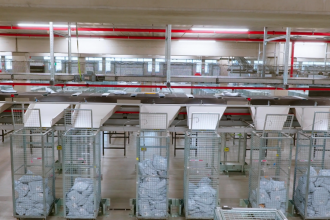Digitization of Intralogistics—Replenishment

Providing traceability and visibility can drastically reduce lost inventory.
As the pandemic laid bare, replenishment is one of the trickiest parts of the supply chain. Supply and demand has proven to be volatile these days, and companies must work extra hard to stave off stock-outs and prevent lost revenue. Within the warehouse, one of the most essential tools to accomplish that goal is digitization of replenishment tasks.
Digital solutions are critical for keeping inventory levels up and ensuring items are available when pickers seek them. These solutions allow for visibility and traceability in order to accomplish both. When you can produce visibility and traceability, your efficiency goes up and no one needs to waste time searching for lost inventory.
To achieve digitization of replenishment, you can start by creating digital map—or a digital twin—of your physical set up. Think of a digital twin as your operations’ version of an avatar. You can interact with the digital twin, learning the attributes of the involved products, the cycles of the products, and any other details you might need to successfully replenish inventory and have it available when needed.
For instance, if you receive a physical box from a supplier into a retail warehouse, you’ll scan its label and then the digital twin will create a virtual representation of the box. In general, a good warehouse management system (WMS) or warehouse control system (WCS) will have the capability to create a map of inventory, assets, and products at the inception, such as receiving. The system transfers that map across the supply chain processes in a digital format.
The larger the warehouse, the more useful this mapping can be. Think of a facility the size of a football field. If you don’t have digitized replenishment, your associates might waste minutes to hours sometimes searching for products to fill orders or fill empty shelves. When they can trace the product’s path and whereabouts, they can lay their hands on it almost immediately. Efficiency goes up, along with the bottom line.
Digitized replenishment is also helpful in reducing losses. Post-Covid, for instance, many companies weren’t providing the requested products to store shelves. This wasn’t because the products didn’t exist in the warehouse—they did. But because they weren’t digitized and pickers couldn’t find them, they reported them as missing or short.
Currently, digitized replenishment is a long way from widespread adoption. But for companies that want to succeed into the future, it will become a necessity. Think of digitized replenishment like the evolution of payroll. What was once an entirely manual process become digitized with the adoption of products like those provided by the ubiquitous SAP. The same will happen eventually with digitized replenishment. Right now, a majority of companies still replenish with traditional manual methods, resulting in lost inventory and profits. When these companies start digitizing replenishment, they’ll simply have to log into their software, see where inventory is and at what level, and begin replenishment.
For more information about the Solutions Community: mhi.org/solutions-community
For further articles from the Solutions Community:
Digitization Of Intralogistics: Labor
Digital Twin for Intralogistics
The Digitization of Intralogistics: Returns
Past vs. Future: The Difference Between On-Premise and Cloud-Based WMS
Sophisticated Condition Monitoring



